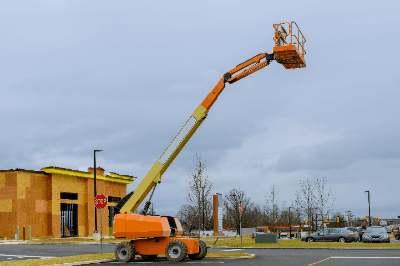What Is an Aerial Work Platform?

An aerial work platform, commonly known as a high-level work vehicle, refers to a construction vehicle equipped with a working platform at an elevated position.
Utilized as scaffolding for workers, it is defined by the following three points:
- It has a working platform at an elevation of 2 meters or more, equipped with an ascending function and a traveling function.
- Power is used for the ascent or descent of the working platform.
- It is capable of traveling to any location during operation.
There are two types of high-level work vehicles: the boom-type structure with a crane-like boom and the vertical lift-type structure, where the ascent and descent of the working platform are purely vertical. The traveling mechanism is divided into truck-mounted, where the working platform is integrated into a truck, and self-propelled, where the lifting device itself has tires. The self-propelled type further includes two variations: tire-type and crawler-type.
Uses of Aerial Work Platforms
The primary application of aerial work platforms is for tasks at elevated heights. Common scenarios for the use of these platforms include maintenance of air conditioning systems, electrical facility installations, moving operations on high floors, and shipbuilding. When used for interior construction, indoor aerial work platforms are chosen.
The purpose of aerial work platforms is to provide a secure scaffolding for work, and the selection of the appropriate platform based on the work location is crucial. In places with poor footing, such as uneven terrain, crawler-type platforms are chosen. Battery-powered aerial work platforms also exist, offering superior noise levels compared to engine-driven ones, making them suitable for indoor use.
Moreover, to operate an aerial work platform, in addition to obtaining a driver’s license, participation in training based on the Occupational Safety and Health Act is required. The permissibility of use also depends on the classification of the driver’s license.
Structure of Aerial Work Platforms
The distinctive features of aerial work platforms include the power source and the working platform balancing device.
1. Power Source
When carrying workers, aerial work platforms typically have a secondary power source to prevent the entrapment of workers in the event of a power source failure.
2. Working Platform Balancing Device
The working platform balancing device automatically keeps the working platform horizontal regardless of the movement of the working equipment. Also known as the leveling device, it can be categorized into wire-type, sensor-type, and cylinder-type.
The wire-type maintains the balance of the working platform through wire tension. The sensor-type detects the boom elevation angle using sensors, allowing for electrical control. The cylinder-type operates the upper balancing cylinder connected to the hydraulic circuit when the elevation of the boom changes, causing oil to flow out from the lower balancing cylinder.
Types of Aerial Work Platforms
Aerial work platforms are classified based on structure and traveling mechanism. The structural types include boom-type and vertical lift-type, while the traveling mechanism includes truck-mounted and self-propelled.
1. Boom Type
Equipped with a crane-like boom, it has extendable, ascending, and swiveling capabilities. Workers can engage in tasks from a basket attached to the end of the boom. Some types have a wider and higher load-bearing platform than the basket and feature a mechanism where certain booms can bend. Aerial work platforms employing the boom type are truck-mounted or self-propelled and have a working platform height of 8 meters or more.
A category known as “Electrical and Communication Equipment Maintenance” exists within the boom type. Electrical and communication work is generally performed near live wires, and for the prevention of electric shock accidents, baskets and booms are made of insulating materials.
2. Vertical Lift Type
The platform ascends and descends vertically and is often used for self-propelled operations with working platform heights ranging from 2 to 10 meters. The vertical lift mechanism includes mast boom type and scissor type. The mast boom type has a vertical boom, while the scissor type uses crossed supporting legs to allow for vertical movement.
Some fire departments have rescue tower vehicles, which are vertical lift-type aerial work platforms converted from fire department vehicles. These vehicles are used for high-level rescues in locations where ladder trucks cannot be used.
3. Truck-Mounted Type
The mechanism for high-level work is integrated into a truck, allowing for legal road travel and rapid movement between bases.
4. Self-Propelled Type
There are two variations of self-propelled platforms: tire-type and crawler-type. The tire-type offers high lifting capacity and the ability to move in a working posture along a ship’s hull, and it can move within a facility. The crawler-type is capable of traveling in narrow and uneven places.